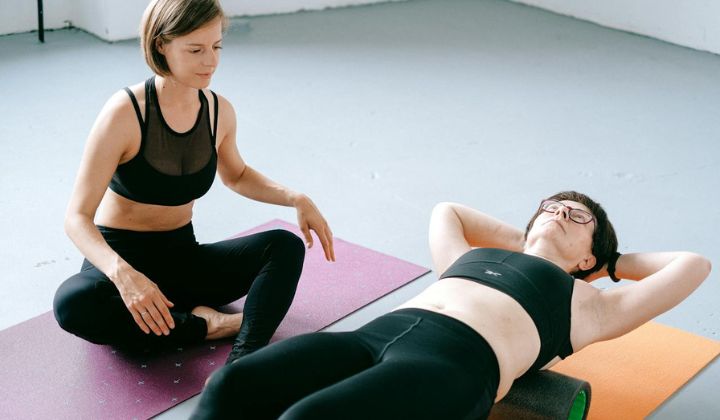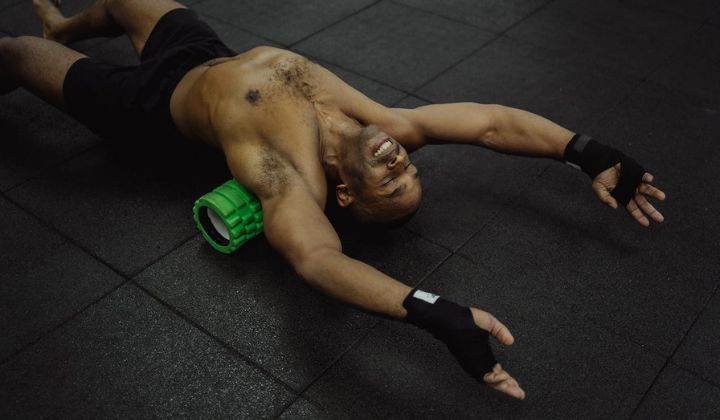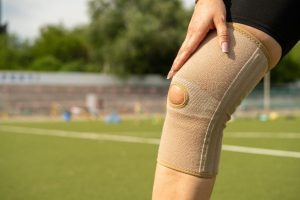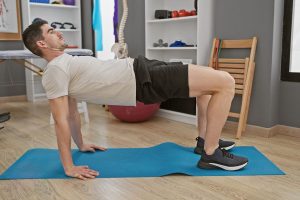Here at Petersen Physical Therapy, we’re pretty big fans of the foam roller, because it provides our patients with a low-cost way to maintain and train the flexibility / mobility improvements they’ve seen from their treatment. That being said, the benefits of foam rolling extend far beyond just its utility in physical therapy.
Some of the benefits of using a foam roller include:
- Localized pain relief
- Reduced inflammation
- Increased passive range of motion (flexibility)
- Improved mobility
- More targeted than stretching
- Increased blood flow
- Speeds up recovery from strenuous activity
- It’s relaxing!
- Foam rolling is empowering (because you can do it on your own!)
In this article, we’ll discuss the foam roller’s benefits, discuss the pros and cons of foam rolling, as well as provide some practical tips for picking a foam roller. In future articles, we’ll provide you with a generalized program to train using a foam roller.
Foam Rolling Benefits
Localized pain relief
Those who have engaged in using foam rollers, Thera Canes, or massage guns to target specific portions of a tight muscle can attest to the fact that these implements can provide almost instantaneous pain relief, even in areas that are extremely tender or sore.
If you’ve ever experienced temporary localized pain relief in an area due to stretching, you can expect a bigger benefit from using a foam roller instead. As discussed above, implements like the foam roller allow us not just to stretch a muscle itself, but to specifically target the tender or sore portion of a muscle belly.
Many people find the pain relieving effects of taking this approach to be dramatic and immediate, as long as they’re applying the proper amount of tension and being sure to avoid direct pressure on bony structures.
Reduced inflammation
Studies have shown that foam rolling after muscle damage has the positive effect of increasing anti-inflammatory proteins and reducing pro-inflammatory proteins. This results in less inflammation to the area and aids in muscle recovery and performance.
Improved passive range of motion (flexibility)
Since foam rolling is a method of directly targeting a specific spot on a muscle and “loosening” the tension there, then we can expect direct and quick improvements in flexibility from training the foam roller properly. For this purpose, the foam roller is a better choice than massage guns (a more targeted approach).
Flexibility training, whether by stretching or foam rolling, has the effect of improving our localized range of motion by 10-15% temporarily. This is most important for those of us engaged in activities that require a large range of motion, but can be equally important for maintaining health during day-to-day activities, like getting up and down from a chair or picking objects up off the ground pain-free.
Additionally, 2-3 weeks of proper flexibility training using the foam roller should provide you with a nice improvement in general flexibility, provided that you keep up with the practice day-to-day.
Improved mobility
We’ve discussed in a previous article on the difference between mobility and flexibility. Though the two are related, they are not the same. Since improving our passive range of motion through flexibility training will have a direct affect on our ability to move through larger ranges of motion (mobility), then foam rolling will directly improve our mobility as well.
More targeted than stretching

One common objection to foam rolling is that it isn’t all that different than simply stretching. While we’re technically doing the same thing (mechanically elongating a muscle belly in order to “stretch” it), the approach and technique of foam rolling vs stretching is very different.
The primary effect of this difference is that foam rolling allows us to self-massage specific trigger points much better than stretching. Slowly rolling over the muscle will allow you to achieve targeted relief of trigger points almost the way a deep tissue massage would.
For instance, we aren’t just stretching the latissimus, we’re attacking a specific point on the latissimus that’s causing us trouble.
For this reason, many patients find they prefer foam rolling for going after those hard to target muscles, or muscles that don’t seem to every loosen up, even when they’re engaging in the proper stretches.
Increased blood flow
NASM’s blog notes that a study they reported on showed a 75% increase in absolute blood flow to an area directly after foam rolling. Improved blood flow not only improves recovery of affected tissues, but it is fantastic for preparing for movement or activity (as part of a warm-up).
This effect can reduce delayed onset muscle soreness (DOMS) when applied post workout or after a strenuous activity.
Speeds up recovery from recovery from strenuous activity
As noted above, foam rolling improves blood flow to the area, reduces inflammation, and promotes mobility. All of these elements add up to an improved ability for muscles to recover from strenuous activity, whether they be physical therapy appointments, exercise sessions, or simply bouts of activity in our daily lives.
It’s relaxing!
We had a funny conversation with a patient not too long ago, where we were discussing the potential pros and cons of using a foam roller. At one point in the discussion, the patient noted, “Science be damned, this thing feels good to use!”
While to conversation was good for a chuckle, it also underscores one of the most important elements of a sustainable exercise program: enjoyability.
The fact is that foam rolling is relaxing and feels good. We’ve almost never shown someone how to properly use a foam roller and had them come out of the session feeling worse. They come out of the session feeling relaxed and with reduced pain. This pain relief led to not just a desire to repeat the activity, but a better attitude about their condition moving forward.
Foam rolling is empowering (because it’s easy to do on your own)
Once you’ve been shown how to use a foam roller, obtaining your own is as simple as visiting the local sporting goods or big box store and picking one up. From that point forward, you can engage in self-massage any time you wish, in the comfort of your own home.
Being able to target small aches and pains as they arise is empowering for our patients, and allows you to have a level of control over your physical health you may not have had access to in the past.
Benefits of foam rolling every day

While we often recommend that patients exercise every other day, or take rest days between physical therapy appointments, foam rolling (like most mobility exercises) can generally be safely performed daily.
The benefits of foam rolling every day can be equated to the benefits of any other stretching or mobility routines daily: we’ll improve flexibility faster and achieve a lasting pain reduction that will improve over time.
In the beginning, we often advise patients to foam roll twice per day: first, directly after getting out of bed, when you’re the stiffest, and a second time right before going to bed, which will decrease stiffness felt in the morning.
After a few weeks, you could back off to foam rolling only once per day, and achieve the same benefits. It’s hard to foam roll too much. One piece of advice we’ve found helpful is to develop a routine that takes around 5-10 minutes at a time. This ensures that you’ll have no problem fitting regular foam rolling into a schedule; it can be easily performed while watching television or listening to a podcast.
Potential cons of foam rolling
Though we do love the foam roller for its portability, low cost, and relative ease of use, there are potential drawbacks to every modality. The foam roller has pros and cons, just like anything else.
Of note is the fact that foam rolling doesn’t penetrate as deep into the tissue as a true massage or a myofascial release session with a professional. However, getting a professional myofascial release session is significantly more expensive and time consuming.
Additionally, simply using body weight to apply pressure to a muscle group can be difficult to regulate. If an area is extremely tender or sore, then even using body weight may be too much, and something that can be applied more gently may be better.
Additionally, we would caution anyone who looks at foam rolling as a “catch all” pain relief solution. The pain relief from stretching, foam rolling, massage, or anything else tends to be temporary and often doesn’t address any underlying issues present. See our full article “Do self-massage tools work?” for a deeper dive on this topic.
If you’ve got a physical ailment that’s troubling you, you’ll be far better off getting the opinion of a professional who can start you on a specific, targeted strengthening and mobility routine to address your pain.
Choosing the right foam roller for you
While the actual form factor of a foam roller is relatively straightforward, they do come in a myriad of sizes and shapes. Subjective experience will vary from person to person, but there are a couple of considerations:
Diameter: Most foam rollers are 5-6 inches in diameter, and we’ve found that to be about right for most applications. Though it’s possible to get foam rollers smaller, in a 1-2 inch diameter, we find that using more targeted implements, like a lacrosse ball, are more effective for applications that require a smaller implement. Additionally, going larger than 5-6 inches in diameter often results in and implement that is too wide to truly massage the muscle belly.
Length: Foam rollers can be 12-18 inches on the short end, or as long as 2-3 feet on the longer end. Consider what you’ll use the foam roller for. Are you planning to pack it in a suitcase or trunk and take it with you? Is it going to simply sit in the corner of a closet?
In general, we don’t see a huge benefit from a longer foam roller, a short 12-18 foam roller should suit most applications just fine.
Aggressiveness: This is where opinions will vary the most dramatically. Some foam rollers are lined with divets or raised dimples to increase the depth of penetration on a muscle belly. Some individuals find this increased aggressiveness to improve the effectiveness of the exercise, but many people simply find them more uncomfortable.
One thing to note is that if you’re using a foam roller lined with dimples, it becomes harder to actually pinpoint an actual spot. If you’re looking for direct application of a targeted point, that is one of the benefits of choosing a massage gun or Thera Cane over a foam roller.
As stated above, one of the benefits of a foam roller is that it’s inexpensive. In our experience, choosing a fancier foam roller over a cheaper, $20 one doesn’t seem to provide a greater result.
Next Steps
If you’re interested in trying out a foam roller, feel free to experiment – there are countless YouTube videos and articles out there on ways to target specific areas of the body for pain relief or release.
That being said, a word of caution: we do advise that you consult with a medical professional or physical therapist first. If you’re struggling with a specific injury, condition, or nagging pain, there is a distinct chance that you’re seeing symptoms of a bigger problem that would be better addressed by a professional trained in evaluating and treating those conditions.
In the upcoming weeks, we’ll provide some foam rolling programs to try for various parts of the body. Until then, happy rolling!

















